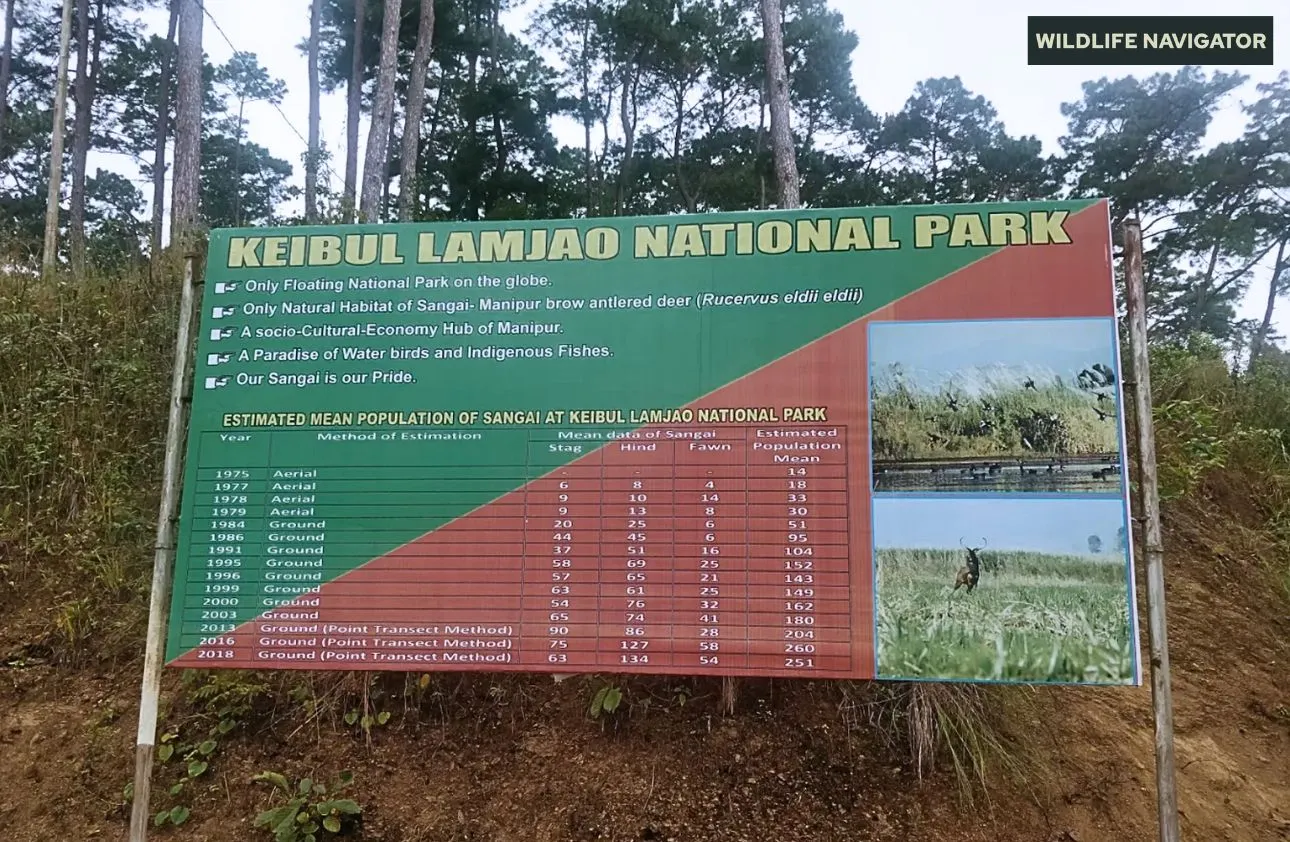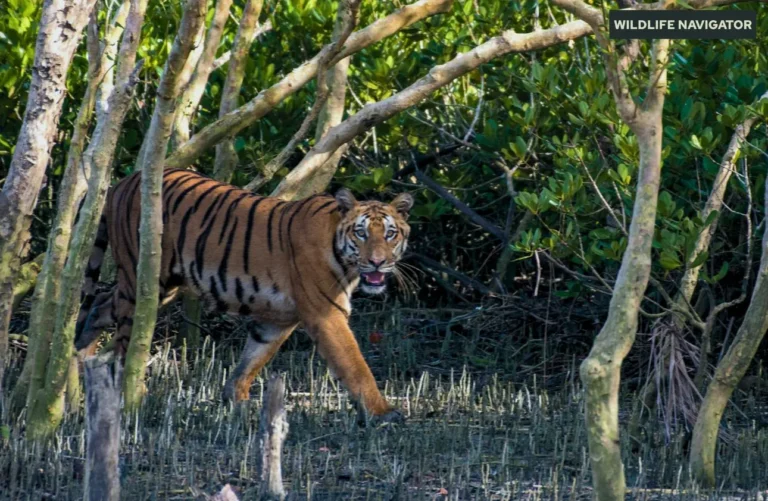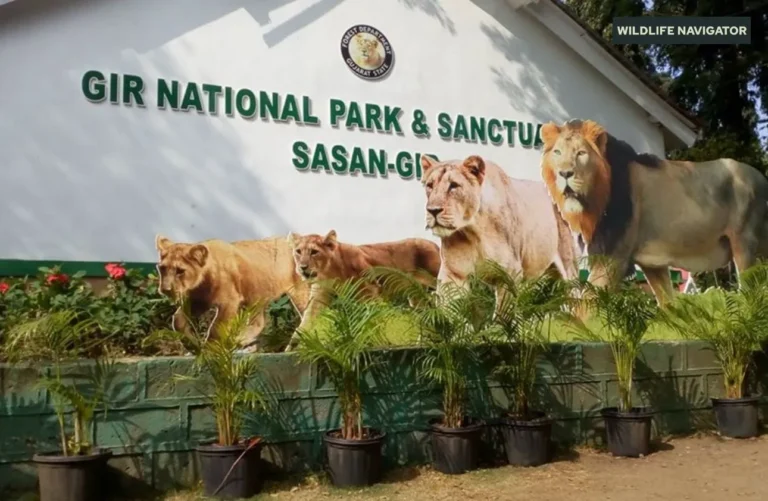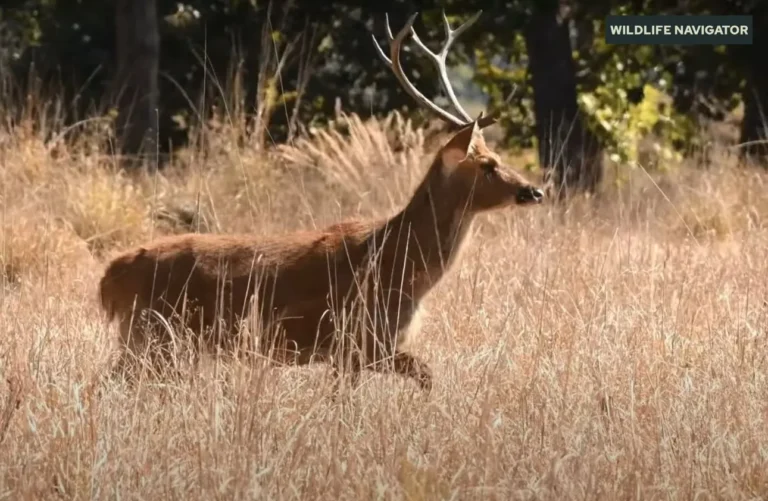Keibul Lamjao National Park: Explore the World’s Only Floating National Park

Keibul Lamjao National Park is one of the most extraordinary wildlife destinations in the world, celebrated for its rare natural formation and critical ecological value. Located within the iconic Loktak Lake in Manipur, counted among the most distinctive national parks in India, it holds the unique distinction of being the world’s only floating national park. This remarkable wetland ecosystem rests on thick floating vegetation called phumdis, creating a landscape where land and water merge in fascinating ways.
The park plays a vital role in preserving one of India’s most endangered and culturally revered species — the Sangai deer, often referred to as the “dancing deer” of Manipur. Beyond its rich biodiversity, Keibul Lamjao stands as a symbol of the deep connection between the people of Manipur and their natural heritage, blending ecological significance with cultural pride.
For nature enthusiasts, wildlife photographers, birdwatchers, and conservation travellers, this park offers an immersive experience into a rare floating ecosystem that exists nowhere else on Earth.
Location, Geography & Floating Ecosystem
Keibul Lamjao National Park is located in the Bishnupur district of Manipur, forming an integral part of Loktak Lake, the largest freshwater lake in Northeast India. The park spans a wetland-dominated landscape that appears solid but is actually a floating mass of compressed vegetation and organic matter.
Location
- Situated about 50 km from Imphal, the capital of Manipur
- Lies along the southeastern region of Loktak Lake
- Surrounded by rural communities dependent on the lake ecosystem
This strategic placement makes the park a central component of Loktak Lake’s ecological network, supporting aquatic life, migratory birds, and rare mammals.
Floating Landscape
At the heart of the park’s uniqueness are phumdis – naturally occurring floating biomass made of vegetation, soil, and organic debris. These floating islands vary in thickness and size, some sturdy enough to support wildlife movement.
Phumdis act as natural platforms for feeding and resting wildlife, particularly the Sangai deer, which relies on them for survival.
Wetland Features
- Seasonal fluctuations in water levels influence phumdi buoyancy and density
- Marshes, channels, and open water pockets form the core landscape
- Supports a nutrient-rich ecosystem ideal for aquatic plants and fish
The constant interaction between land and water creates a dynamic environment where vegetation floats, wildlife adapts to shifting ground, and hydrology shapes the ecosystem’s rhythm.
History & Significance
Keibul Lamjao National Park evolved from a critical need to protect an endangered species and a fragile wetland ecosystem. Its history reflects a strong commitment to safeguarding the Sangai deer and preserving Manipuri ecological heritage.
Establishment
- Originally declared a sanctuary in 1966
- Upgraded to National Park status in 1977 to ensure stricter protection
- Created primarily to save the Sangai from extinction, as the population had dropped drastically due to hunting and habitat pressure
Conservation efforts intensified after the Sangai was rediscovered in this region, reinforcing the global importance of this floating wetland habitat.
Cultural Importance
Keibul Lamjao holds deep cultural value for the people of Manipur. The Sangai is revered in local folklore, symbolising grace, identity, and deep-rooted ties between humans and nature.
Key cultural aspects include:
- The Sangai is celebrated in Manipuri legends, traditional dance forms, and art
- Loktak Lake and its floating meadows feature prominently in local livelihoods, fishing traditions, and community identity
- The region is viewed not only as a wildlife refuge but also as a living cultural landscape
Through its long-standing ecological and cultural legacy, Keibul Lamjao National Park represents a rare intersection of conservation significance and regional identity, protecting both nature and heritage for future generations.
Wildlife & Biodiversity
Keibul Lamjao National Park supports a rich wetland ecosystem that sustains a wide range of species uniquely adapted to its floating meadows and aquatic environment. Although relatively compact in size, the park’s biodiversity is significant due to its specialised habitat and proximity to Loktak Lake.
Major Fauna
The park is best known as the last natural refuge of the Sangai deer (Rucervus eldii eldii). In addition to this flagship species, the ecosystem supports:
- Hog deer
- Wild boar
- Civets
- Otters
- Small Indian mongoose
The floating vegetation and marsh-filled terrain offer feeding and breeding grounds that are critical for these mammals.
Birds & Waterfowl
Keibul Lamjao is an important habitat for resident and migratory birds, making it a notable birdwatching destination.
Key species include:
- Eastern jungle crow
- Lesser whistling duck
- Northern shoveler
- Gadwall
- Spotbill duck
- Pheasant-tailed jacana
- Purple swamphen
These wetlands serve as seasonal rest points for several migratory waterbirds, contributing to the region’s avian richness.
Flora
The park’s plant life is dominated by marsh vegetation and aquatic plants, thriving in nutrient-rich waters and floating soil mats. Common vegetation types include:
- Floating grasses on phumdis
- Aquatic hydrophytes
- Algae and reeds
This dense wetland vegetation forms the structural backbone of the habitat, sustaining wildlife while maintaining the ecological balance of Loktak Lake.
Keibul Lamjao’s biodiversity reflects a finely balanced ecosystem, where species have evolved to thrive on an ever-shifting, floating landscape—a natural marvel found nowhere else on the planet.
The Sangai – Pride of Manipur
The Sangai, often called the “dancing deer”, is the most iconic species of Keibul Lamjao National Park and the primary reason for its conservation importance. This rare subspecies of the Eld’s deer is endemic to Manipur and represents one of India’s most vulnerable large mammals.
Species Profile
The Sangai is recognised for its distinctive features:
- Elegant antlers with three tines
- Light brown coat with coarse fur
- Slender build adapted to marshy terrain
It is listed as Endangered due to its restricted habitat and limited population, making conservation efforts critical.
Behavior & Habitat
The Sangai has evolved to live on floating grasslands, where it moves gracefully across the soft, buoyant phumdis—giving it the appearance of dancing. Notable behavioural traits include:
- Grazing on marsh grasses and aquatic plants
- Moving lightly to avoid sinking into the floating soil
- Living in small herds and showing territorial behaviour during breeding seasons
The phumdi environment is essential to Sangai survival; any disturbance to this floating habitat threatens the species directly.
Symbolism
In Manipur’s culture and mythology, the Sangai is more than just a deer—it symbolises grace, dignity, and the soulful connection between nature and people. It is frequently depicted in traditional dance, folklore, and crafts, reinforcing its role as a cultural ambassador for the state.
The Sangai stands as a powerful reminder of the fragile balance between wildlife and their habitat, and its existence underscores the importance of ongoing conservation at Keibul Lamjao.
Conservation Challenges & Efforts
Keibul Lamjao National Park faces unique conservation challenges due to its floating ecosystem, human dependence on Loktak Lake, and the fragile status of the Sangai deer. Protecting this habitat requires coordinated ecological management and community participation.
Threats
- Hydrological changes caused by the Loktak Hydroelectric Project have altered water levels, weakening phumdis and reducing secure ground for wildlife.
- Habitat degradation from unchecked vegetation harvesting, tourism pressure, and development activities.
- Poaching and illegal activities, although reduced, still pose risks to wildlife, especially during low-visibility periods in marsh zones.
- Fishing pressure, including the use of athaphums (artificial fishing enclosures), which disrupt natural water flow and affect phumdi stability.
- Climate impacts, such as changing rainfall patterns and drought cycles, influencing lake levels and wetland health.
Initiatives
Government bodies, scientific institutions, and local communities collaborate to preserve this delicate ecosystem.
Key measures include:
- Protected area regulations and patrols to prevent illegal hunting and resource extraction.
- Phumdi restoration programs to enhance stability and maintain habitat quality for the Sangai.
- Loktak Lake Management initiatives, including water level monitoring and wetland rehabilitation.
- Community-driven conservation, where local fishers, residents, and eco-tourism groups participate in awareness and sustainable use practices.
- Research and population monitoring of the Sangai to support data-based conservation planning.
Sustained efforts remain essential to secure the floating habitat and ensure long-term survival of the Sangai and Loktak Lake ecosystem.
Visiting Keibul Lamjao National Park
Keibul Lamjao offers a distinctive wildlife experience where wetlands, floating grasslands, and rare species come together in a serene natural setting. Visiting allows travellers to witness the unique floating ecosystem while learning about conservation efforts in Manipur.
Best Time to Visit
The ideal time to explore the park is October to March, when weather is pleasant and water levels remain stable. This season offers:
- Better visibility of the floating meadows
- Higher chances of spotting Sangai deer
- Ideal conditions for birdwatching and photography
The monsoon period (June–September) brings high water levels, limiting access and reducing wildlife sightings.
Entry & Regulations
The park has designated entry points and viewing areas to ensure minimal disturbance to wildlife.
Visitors should note:
- Entry is usually permitted during daytime hours only
- Guided visits and observation points help protect phumdis
- Drones, loud noises, and off-trail movement are prohibited
Visitors are encouraged to coordinate with local tourism offices or forest authorities before arrival for updated rules, seasonal access notes, and any required permissions.
This section sets the stage for a responsible and rewarding experience, ensuring visitors enjoy the natural beauty while supporting conservation goals.
How to Reach Keibul Lamjao National Park
Keibul Lamjao National Park is accessible through well-connected transport routes linking it to Manipur’s capital and nearby regions. Travellers typically begin their journey from Imphal, the nearest major hub, before heading toward the Loktak Lake region.
Nearest Airport
- Imphal International Airport (approx. 45–50 km from the park)
- Provides regular flights from major Indian cities such as Delhi, Kolkata, and Guwahati
From the airport, taxis and rental vehicles are easily available for the onward journey to the park area.
Nearest Railway Station
- Dimapur Railway Station (Nagaland) is the closest major railway link, located around 215–230 km away
- From Dimapur, visitors can travel to Imphal by road (bus or taxi services available)
Since Manipur currently lacks a functional passenger railway terminal near the park, road travel from Dimapur remains the preferred rail-connected route.
By Road
- The park lies roughly 2 hours from Imphal by road
- NH-2 connects Imphal to Moirang and Bishnupur, from where local roads lead to the park area
Transport options include:
- Private taxis and cabs
- Local buses to Moirang, followed by shared transport to the Loktak Lake area
- Self-drive rentals (recommended for flexibility)
The drive from Imphal features scenic countryside, giving travellers their first glimpse of Manipuri rural life and lake landscapes before arriving at the gateway to the floating national park.
Things to Do
Keibul Lamjao and the surrounding Loktak Lake region offer immersive experiences rooted in nature, wildlife observation, and cultural exploration. Visitors can enjoy a calm, nature-focused itinerary emphasising ecological appreciation and local connections.
Wildlife Viewing
The primary attraction is the opportunity to spot the Sangai deer moving gracefully across floating meadows. Observation towers and designated viewing points provide clear vantage spots without disturbing the habitat.
Birdwatching
The wetlands support numerous resident and migratory bird species. Early mornings and late afternoons are ideal for sightings of ducks, jacanas, and other wetland birds.
Loktak Lake Activities
Exploring Loktak Lake complements the park visit. Activities include:
- Traditional boat rides
- Observing floating huts and fishing communities
- Viewing vast phumdi fields and lake panoramas
These experiences highlight the deep relationship between people and the lake ecosystem.
Nearby Spots
Several scenic and historic sites lie close to the park:
- Sendra Island: Offers sweeping views of Loktak Lake
- INA Memorial at Moirang: Historical site linked to India’s freedom struggle
- Thanga and Karang Villages: Known for fishing culture and lake life
These nearby attractions enrich the visit by blending nature, history, and community encounters.
Accommodation
Staying near Keibul Lamjao allows visitors to experience the calm environment of Loktak Lake while remaining close to wildlife viewing zones. Lodging options range from eco-friendly stays to basic guesthouses, offering comfort with proximity to nature.
Eco-Resorts and Homestays
Several eco-stays and lakeside homestays operate around Moirang, Thanga, and Sendra. These accommodations often provide:
- Lake-facing rooms or cottages
- Local cuisine with fresh ingredients
- Guided nature walks and boating options
- Quiet, natural surroundings ideal for sunrise and sunset viewing
Homestays also give travellers opportunities to engage with local communities and understand the lifestyle connected to Loktak’s wetlands.
Basic Guesthouses
Budget-friendly guesthouses and rest houses are available near Moirang and along the approach road to the park. These typically offer:
- Clean rooms and essential amenities
- Easy access to food stalls and transport
- Convenient base for short visits
Early booking is recommended during peak tourist months (October to March), especially if seeking eco-resort stays or rooms with lake views.
Responsible Travel Tips
Keibul Lamjao is a fragile wetland ecosystem, and responsible visitor behaviour is essential for preserving its floating habitat and wildlife. Travellers should adopt low-impact practices to ensure conservation and community benefits.
Wetland Protection Practices
- Stay on designated trails and viewing platforms to avoid damaging phumdis
- Avoid feeding wildlife or interfering with natural behaviour
- Do not enter restricted or marshy zones without authorised guidance
These steps help maintain the delicate structure of the floating meadows and minimise stress on wildlife.
Sustainable Waste & Plastic Use
- Carry reusable water bottles and avoid single-use plastics
- Take all waste back with you if disposal bins are not available
- Avoid littering in and around the lake or park approach areas
Maintaining cleanliness supports the lake’s ecological health and prevents plastic from entering the water system.
Wildlife-Safe Behaviour
- Maintain silence to avoid disturbing animals, especially the Sangai
- Avoid flash photography and loud equipment
- Observe wildlife from a safe distance through binoculars or scopes
Ethical conduct ensures natural behaviour and safer wildlife encounters.
Support Local Communities
- Choose local guides, homestays, and community-run experiences
- Purchase local handicrafts or products when available
- Respect cultural practices and interact politely with residents
Community involvement strengthens conservation efforts and supports livelihoods.
Following these principles helps preserve Keibul Lamjao’s unique ecosystem and ensures that future visitors can experience its natural and cultural richness.
Conclusion
Keibul Lamjao National Park stands as a rare ecological wonder and an invaluable sanctuary for the endangered Sangai deer. As the world’s only floating national park, it represents a delicate balance between land, water, and life, shaped by the phumdi ecosystem and nurtured by the cultural heritage of Manipur.
Beyond its scientific and conservation significance, the park offers a chance to witness a landscape found nowhere else on Earth, where wetlands support unique wildlife and centuries-old human traditions.
Protecting this fragile environment requires continued community involvement, sensitive tourism practices, and sustained conservation efforts. A visit to Keibul Lamjao is not only a journey into a remarkable ecosystem but also a reminder of the importance of preserving nature’s rarest creations.





